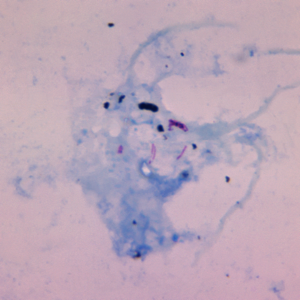By Allison Hydzik
A novel tuberculosis (TB) vaccination strategy that uses Bacille Calmette-Guérin (BCG) vaccine could prevent the leading cause of death among people living with HIV worldwide, according to scientists at the University of Pittsburgh.

When given intravenously, BCG effectively and safely prevents lung infection in monkeys infected with the simian HIV (SIV). BCG is currently contraindicated for people living with HIV (Nat Microbiol 2023 Oct 9. doi:10.1038/s41564-023-01503-x).
“What is really exciting about this study is that, for the first time, we’re seeing complete protection from TB in a model of HIV. This hasn’t been shown before,” said lead author Erica Larson, PhD, a research assistant professor in Pitt’s Department of Microbiology and Molecular Genetics. “This shows that there’s potential to protect people living with HIV against TB.”
One in three people living with HIV die of TB, making it the world’s second leading infectious killer after COVID-19. Worldwide about 1.6 million people die of TB annually, including almost 200,000 people living with HIV, according to the World Health Organization.
BCG—among the most widely used vaccines—has been used against TB for about 100 years. It is made of attenuated Mycobacterium bovis, which is closely related to M. tuberculosis, the cause of human TB. BCG is mostly given to infants and children by injection into the skin, but it offers minimal protection from M. tuberculosis, particularly against lung infection.
Previously, scientists at Pitt and National Institutes of Health showed that IV BCG vaccine is highly protective against TB, including lung infections, in monkeys (Nature 2020 Jan 1). The new study builds on these findings.
With the encouraging results from the previous experiment, the team decided to try it on monkeys with SIV. But they did something unique. About three weeks after vaccination, they gave the monkeys antibiotics to kill all the live-attenuated bacteria in the vaccine. Their hope was that the BCG vaccine had enough time to stimulate the immune system to protect against a real TB infection, but not enough time for the attenuated bacteria in the vaccine to cause disease in the immunocompromised monkeys.
The gamble paid off. Not only did none of the animals get sick from the BCG vaccine, but, most importantly, 75% of the monkeys with SIV that were vaccinated received IV vaccine followed by antibiotics a few weeks later went on to successfully fight off TB infections. Intravenous BCG vaccination also protected all the monkeys without an SIV infection. The only animals in which the vaccine did not work to prevent TB were those that had advanced SIV disease, likely because they were immune depleted.
The scientists noted that this strategy is not going to be practical—especially in low- and middle-income countries. People with HIV might have trouble coming back for antibiotics three weeks after vaccination. They plan to test the safety of IV BCG without using any antibiotics, as well as testing new BCG vaccines in development that self-destruct before they can cause disease in immunocompromised people, yet are still able to prevent TB.
“TB is rampant in parts of the world where there isn’t a really good public health infrastructure,” said Charles Scanga, PhD, a research associate professor in Pitt’s Department of Microbiology and Molecular Genetics, and a member of Pitt’s Center for Vaccine Research. “Unfortunately, those are also places where HIV goes undiagnosed or untreated and spreads. So, epidemiologically, TB and HIV go hand-in-hand. Prevention in the form of a realistic TB vaccination strategy is going to be key to saving hundreds of thousands of lives each year. And I’m hopeful that our study is a big step in that direction.”
Originally posted on the University of Pittsburgh website. The content was edited for style and length.
{RELATED-HORIZONTAL}